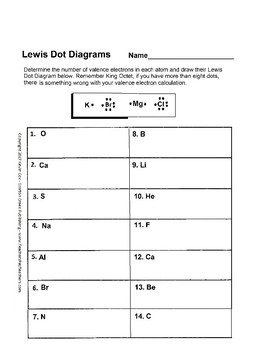Results for lewis dot diagram
350 results- Relevance
- Rating
- Price (Ascending)
- Most Recent
- List
- Grid
These scaffolded Cornell Doodle Notes combine two effective note-taking strategies and can be used as a mini-lesson on how to draw a Lewis Dot Diagram to show the valence electrons of an atom. There is a Let’s Try practice space in which students draw the Lewis Dot Diagrams for elements #1-18.These notes can be used as part of the input for NGSS HS-PS1-1: Use the periodic table as a model to predict the relative properties of elements based on the patterns of electrons in the outermost energy le
Subjects:
Grades:
7th - 9th
Also included in: Physical Science Cornell Doodle Notes Bundle
Physical science, chemistry worksheet covering electron dot/Lewis dot structures of s-block and d-block elements (all 7 periods of the periodic table).answer key includedCredits: Cover page icons designed by Freepik from Flaticon Terms of Use: Purchase of this product is for single classroom use by the purchaser only. It is a violation for individuals, schools, and districts to redistribute, edit, sell or post this item on the Internet or to other individuals. Disregarding the copyright is a vi
Subjects:
Grades:
7th - 10th
Types:
NGSS:
Also included in: BIG Bundle of Chemistry
This is a well laid out Bohr diagram and Lewis Dot structure worksheet for struggling students in placing the electrons around the nucleus.
There are empty boxes around the shells so that students will understand where to place the electrons and to follow the 2-8-8 rule.
The questions on the side are also great lead up questions to guide the students how to calculate the necessary numbers to draw Bohr models and Lewis Dot structures.
Subjects:
Grades:
8th - 10th
Types:
Also included in: All of my items listed in my store!
I noticed my students needed to understand valence electrons in order to predict chemical reactions. Although Lewis dot diagrams are not as difficult to master as Bohr diagrams, they still require a little practice. I created this worksheet so that my students could practice and master Lewis dot diagrams and gain a strong understanding of the valence shell and how it can help with predicting reactions and bonding between atoms. I have used this in both a middle school classroom and a high school
Valence Electrons -- if students don't understand them, then how can they ever learn to bond? (I made a pun there...I'll get my coat. :-) )
This is a set of 20 task cards for Valence Electrons and Lewis Dot Diagrams. I have included a Student Response document and an Answer Key with suggested answers.
Topics Covered Include:
~ Identify the Element
~ Understanding Valence Electrons
~ Predicting Ions
~ Stable Octets
~ Introduction to Basic Atomic Structure (2, 8 Energy Levels)
~ Identify the Le
Subjects:
Grades:
6th - 11th
Types:
CCSS:
This powerpoint presentation teaches students about valence electrons and how to draw them. It shows a shortcut (Lewis Dot) so you don't have to draw all those darn electrons! Overview of how to draw them and 5 practice problems are included. You might also be interested in:Types of Bonds powerpointElements, Compounds, and Mixtures powerpointChemical Bonds Flip BookBe sure to follow my TpT store by clicking on the green "follow me" next to my seller picture to receive notifications of new produc
Also included in: Chemistry Bundle
The complete, no prep., bundle containing:Bohr-Rutherford Diagrams for the 1st Twenty Elements, with Answers;Lewis Dot / Valence Electron Diagrams for the 1st Twenty Elements with Answers;&Bohr models for all elements on the periodic table (1-118).Click here to follow my store and receive the latest updates.Original Artwork (©AwesomeScience). For Personal Use Only. Uneditable.Page count does not include Terms of Use and links to supplementary activities. Copyright ©AwesomeScience 2013 – The
Subjects:
Grades:
7th - 12th, Higher Education
CCSS:
NGSS:
These PAPERLESS, SELF-GRADING chemistry assessments will save you time and provide you and your students immediate, meaningful feedback. This resource includes two 12 question quizzes and one large assessment with all 24 questions. Aside from uploaded images, many questions and answer choices are EDITABLE- add/delete/revise/rearrange questions to fit your students' needs. Note: most of the answer choices in this problem set are dot diagram images which can not be edited.⭐Ideal for DISTANCE LEA
Subjects:
Grades:
7th - 12th, Higher Education
Types:
NGSS:
Also included in: Chemistry Self-Grading Quiz Assessments 20 Topic BUNDLE for Google Forms
Student Objectives:Identify the 3 subatomic particles, their charges, and describe how they are arranged in atoms. Use a Periodic Table and apply the Octet Rule to create electron configuration diagrams (Lewis Dot and Bohr Models). Students will follow directions to label the charges and locations of the subatomic particles, then complete 7 Bohr Model Diagrams and 7 Lewis Dot Structure Problems. There are text boxes and drag and drop elements for them to build their models. This assignment can b
This digital or printable worksheet reviews identifying ionic and covalent bonds and compounds, their elements and Lewis Dot Diagrams showing how the valence electrons are configured(HS-PS1 and MS-PS1-2). Other chemistry resources:**Changing States of Matter REVIEW ASSESSMENT **Changing States of Matter Scavenger Hunt**ANALYZING MOLECULES COMPOUNDS Count How Many Atoms? Elements? 2 Worksheets**DIAGRAMMING CHEMICAL EQUATIONS- PREPARATION FOR BALANCING MS-PS1-1 Conservation**BALANCING CHEMICAL EQU
Subjects:
Grades:
8th - 10th
Types:
Also included in: BASIC CHEMISTRY BUNDLE! 8 resources MS-PS1 HS-PS1
This 2-page worksheet product is designed to introduce upper middle school and lower high school chemistry students to drawing electron dot or Lewis dot diagrams through a brief tutorial and an activity where students record the name, chemical symbol and correct electron dot diagrams for the first 18 elements, and 5 analysis questions.How I Use This Product:I use this product after teaching students how to draw Bohr diagrams using the exercise entitled, Drawing Bohr DiagramsA link to this resour
Subjects:
Grades:
6th - 9th
Types:
NGSS:
About SNAPs Lab Stations ActivitiesSNAPs Lab Stations Activities require students to use science, math, literacy, problem-solving and engineering skills. They are designed to enhance students' understanding of scientific concepts and help students apply scientific ideas to the real world. Each station activity promotes skills so to develop students into proficient and competent scientific thinkers.SNAPs lab activities have five components:• Science Skills Station to develop science skill profici
Subjects:
Grades:
6th - 10th
Types:
NGSS:
These Task Cards are meant to help students understand how to identify an atom, how the periodic table is organized and also understand how the Lewis Dot Diagram groups elements through visuals.
When looking at a task card, the student needs to be able to identify the element based on the image provided. Using the clues, they will then write in the elements name, what group and period it can be found in and also its chemical reactivity. Chemical reactivity is the elements tendencies to lose or
Students practice Lewis Dot Diagrams for the 1st 20 elements on the Periodic Table.Simple instructions for completing dot diagrams, follow-up questions and 2 extensions (games) included.Use this activity as part of an interactive notebook.Related resources:⭐ Introduction to Bonding Cornell Notes #37⭐ Brain POP Chemical Bonds Guided Notes⭐ Chemical Bonds - Cornell Notes #38⭐ Chemical Bonds Semantic ChartMore notes, games & foldables available at Sandy's Science.Florida Next Generation Sunshin
Also included in: Chemical Bonding Introduction Notebook Bundle
This card sort will prepare 9th and 10th grade physical science and chemistry students to identify and fill out Lewis electron dot diagrams as well as the oxidation numbers of each family using the Periodic Table of Elements. After completing this activity, students will be able to see the relationship between valence electrons and charges for each group of elements. Digital and PDF with answer sheet and cut & paste version are included. Important Informationdigital Easel version is compat
Subjects:
Grades:
9th - 11th
Types:
CCSS:
NGSS:
Also included in: Bundle of Lessons - Lewis Electron Dot Diagrams
Students will need a periodic table for this warm-up/ activity. Students will find the protons, neutrons, and electrons in atoms, then create Bohr Models and Dot Diagrams using the information. The first problem is completed as an example.The elements include:LithiumCarbonBerylliumNeonNitrogenOxygenSodiumAluminiumAlso, included is a vocabulary sheet that can be used as a homework assignment.GREAT WARM-UP/ BELL RINGER OR HOMEWORK ASSIGNMENT!_________________________________________________CUSTO
Subjects:
Grades:
6th - 9th
Types:
Your students will identify and match the Lewis electron dot diagrams to their corresponding element symbols. Students simply drag element symbol to the correct structures and push "submit". Perfect way to check for understanding, review, or use as a quiz or short test. The answers are presented in a multiple choice format. Click here for Lewis Dot Diagram Boom Card preview Important InformationAnswer keys includedOnline Boom Card version is self gradingRecommended for physical science and chem
Also included in: Bundle of Lessons - The Periodic Table of the Elements
This activity is in an Interactive Notebook format on google slides. Students will predict the amount of valence electrons and move the dots around to form the covalent bonds to satisfy the octet rule. Key is included in the last slides at the end of the slide presentation. There are 14 molecules in this activity, and three of them have coordinate covalent bonds and there are five polyatomic ions where students need to add or remove electrons from the diagram to compensate for the charge of the
About this Product• This download includes G Suite designed resources needed for one 45-minute science lesson.• The resources are re-bundled and re-formatted from my Chemistry Unit Bundle.• Purchase the materials for the topic(s) pertinent to your classroom - not an entire unit!• Files in this download are optimized for use with G Suite Applications (Slides, Docs and Forms)Google Classroom Lesson Unit BundleThis G Suite Designed Lesson is part of the Chemistry Google Classroom Lesson Bundle. Les
Also included in: Chemistry Google Classroom Lesson Bundle | Digital & Printable
This Bundle includes:Periodicity and Electrons - Step by Step Worksheet- students will examine the relationships between periods and energy levels as well as families and valence electrons - the Bohr diagrams and Lewis dot diagrams allow students to visualize how these relationships repeat on the periodic table- illustrates the direct relationship between the family number, valence electrons, and oxidation number- students will draw and compare different conceptual models for the electrons aroun
Students can practice their electron dot diagram construction skills with this fun and engaging activity. This activity includes 10 different compounds and students are requested to make the electron dot diagram from scratch by using the elements and electrons provided in a drag and drop fashion. Answers have been provided for each diagram so that students can compare their diagrams to that of the answer key.This activity is a no prepper and time saver, as everything has already been prepared an
This worksheet is part of a bundle!
Science Maze 8th Grade Chemistry Bundle $10.00
This is a worksheet meant to help kids understand the Lewis dot diagram.
Starting at the big atom, the student must understand the lewis Dot Diagrams to complete the maze. For diagrams with a Chemical Symbol, the student must only recognize what group it belongs to. For diagrams with an X, the student must know which elements belong to that group. The student must then follow the arrow that contains the corre
- students will examine the relationships between periods and energy levels as well as families and valence electrons - the Bohr diagrams and Lewis dot diagrams allow students to visualize how these relationships repeat on the periodic table- illustrates the direct relationship between the family number, valence electrons, and oxidation number- students will draw and compare different conceptual models for the electrons around an atom- teach students to show their work step by step with boxes fo
Also included in: Bundle of Lessons - The Periodic Table of the Elements
Lewis Dot Diagram allows chemistry students to displays the valence electrons of an atom. This worksheet allows them practice creating each for 14 atoms. Students should be able to do the electronic configuration of the atoms ahead of time.



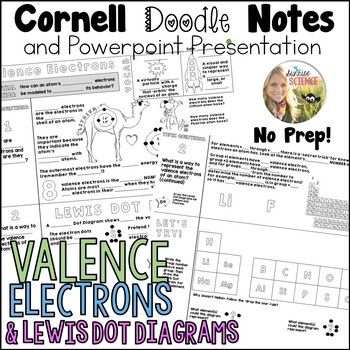





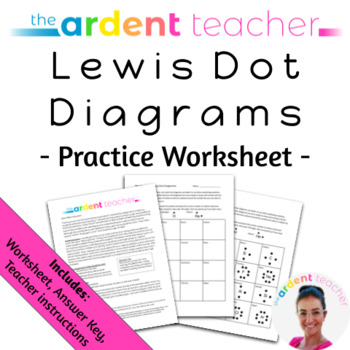



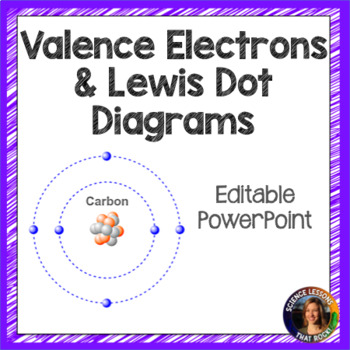

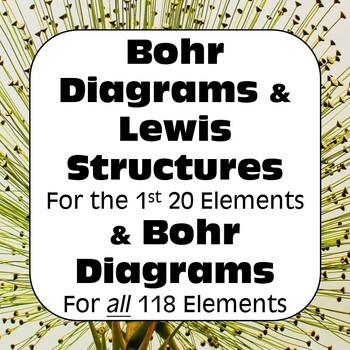

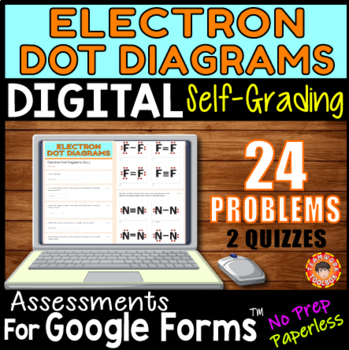

 Google Apps™
Google Apps™







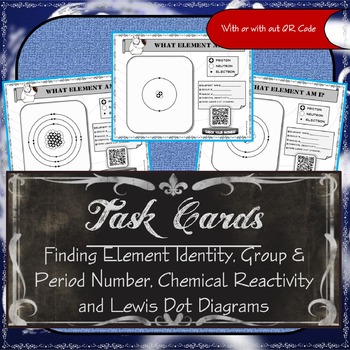
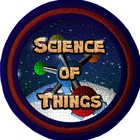
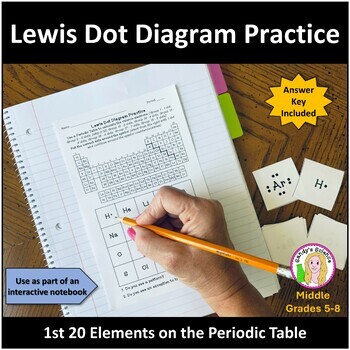
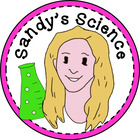
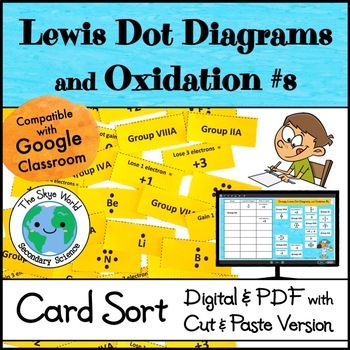

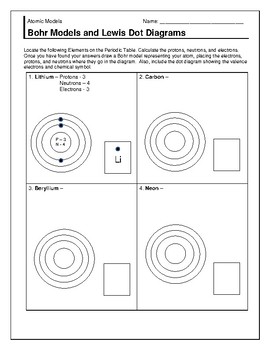

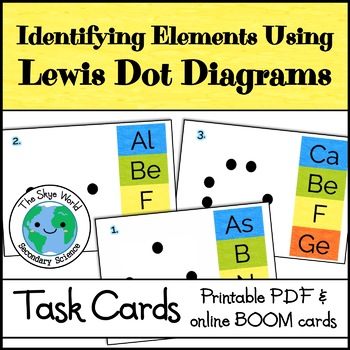


 Google Slides™
Google Slides™





